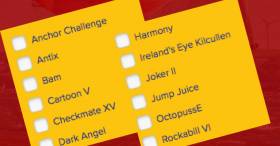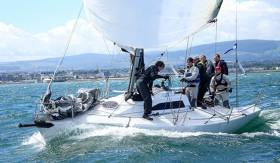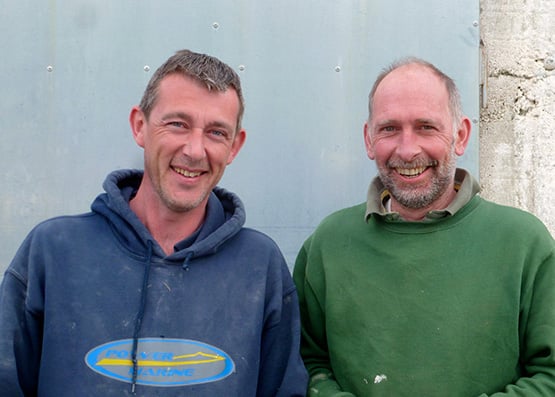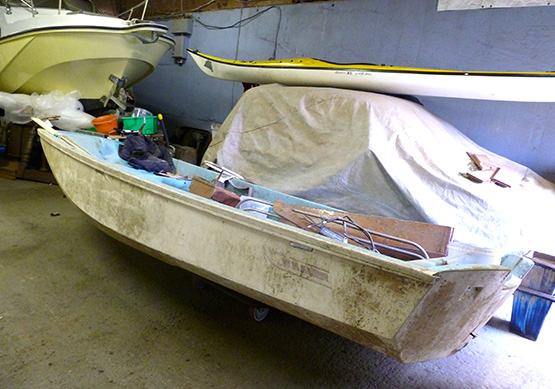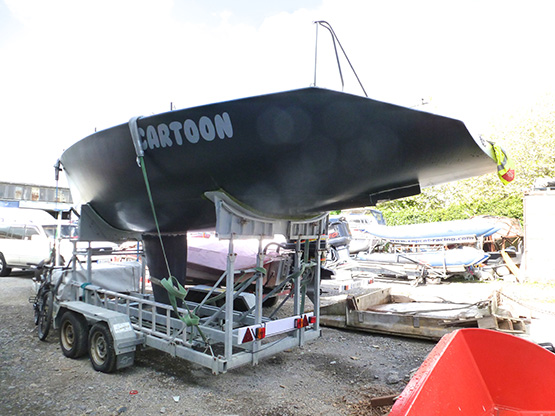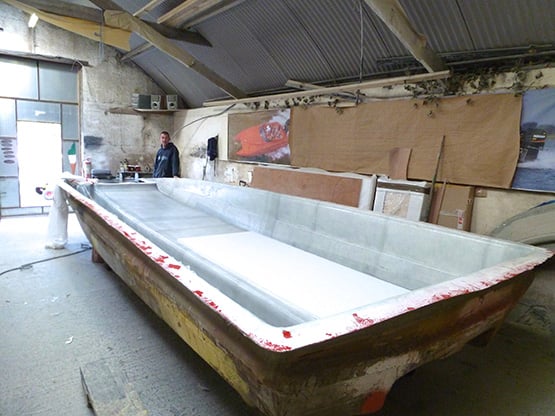Displaying items by tag: Checkmate XV
Half Tonner Checkmate XV is for Sale
Probably the best looking and most successful Half Tonner ever is on the market via Afloat boats for sale as the Howth Yacht Club based Checkmate XV goes on sale for €46k.
"No expense has been spared on this incredible race machine that is faster now than ever", according to her owner Dave Cullen.
With a full IRC refit by Corby Yachts in 2014, the current Half Ton Class European Champion comes complete with a Mills design keel and a Corby designed rudder, the hull also has a fully faired hull, keel and rudder.
AwlGrip hull and deck paint. Nautics antifouling. Deck resprayed 2020. Seadek cockpit floor. Full Harken winch and deckware package.
The boat is the winner of every major regatta in Ireland including WAVE (overall regatta winner), Volvo Dun Laoghaire Regatta and the ICRAs. Read the full advert here.
ICRA’s 'Boat Of The Year'? You Choose
The Annual Conference of the Irish Cruiser Racer Association (ICRA), an absorbing all-day affair in Limerick this Saturday (March 4th), has an intriguing agenda writes W M Nixon. But for many sailors from all over Ireland and the other side of the Irish Sea, the high point of it all will be the announcement of the ICRA “Boat of the Year” selected by the ICRA judges.
We revive memories of the great year of 2016 by running our own informal poll - just click as you wish on this alphabetic list at the bottom of this story to see whose achievements rise up the ranking. We can only say that that the wealth of choice speaks highly of the great good health and re-growing popularity of “waterborne truck racing”
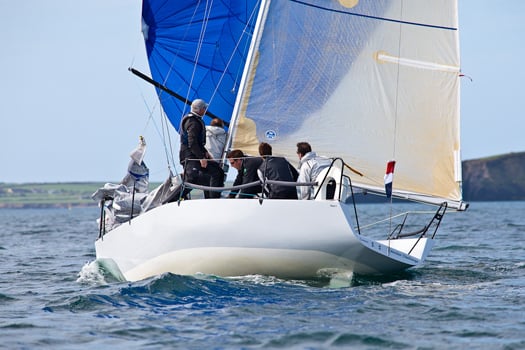 QUARTER TONNER Anchor Challenge – Paul Gibbons from Royal Cork Yacht Club. Photo: Bob Bateman
QUARTER TONNER Anchor Challenge – Paul Gibbons from Royal Cork Yacht Club. Photo: Bob Bateman
Anchor Challenge: Paul Gibbon’s classic Quarter Tonner from Crosshaven was good on enthusiasm, and good on performance, her top line being the overall win in the IRC Europeans at Crosshaven in July, which he plans to defend at Marseilles this summer.
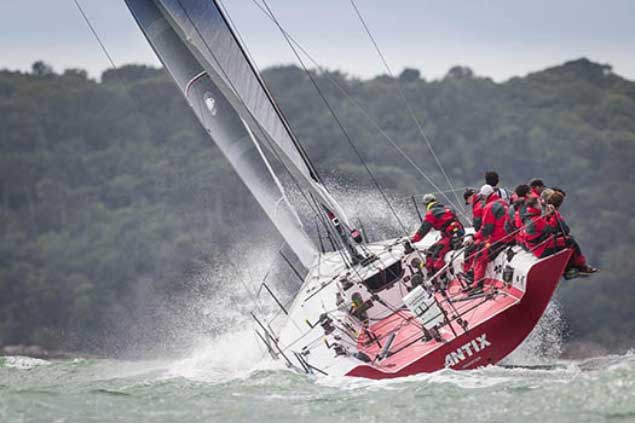 KER39 Antix – Anthony O'Leary from Royal Cork Yacht Club. Photo: Paul Wyeth
KER39 Antix – Anthony O'Leary from Royal Cork Yacht Club. Photo: Paul Wyeth
Antix: Anthony O’Leary’s Fast Forty+ may not have had her most successful season ever in 2016, but many crews would give their eye teeth to have a record as good, topped with the Class O win in the IRC Europeans in Cork Harbour in July.
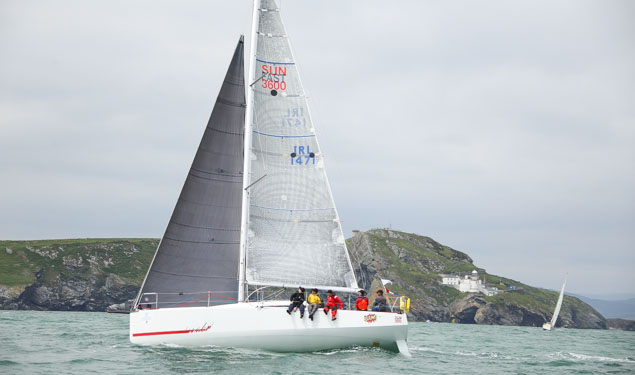 SUNFAST 3600 BAM! - Conor Fogerty from Howth Yacht Club. Photo: Afloat.ie
SUNFAST 3600 BAM! - Conor Fogerty from Howth Yacht Club. Photo: Afloat.ie
Bam!: With the complexities of the RORC Caribbean 2017 still fresh upon us, we realize just how good was Conor Fogerty’s Class win in 2016 in this demanding maze of a race around the islands with his Sunfast 3600 Bam!. And on top of that, it was all just part of an extraordinary season with thousands and thousands of miles of sailing and racing
 HALF TONNER Checkmate XV – David Cullen from Howth Yacht Club. Photo: Afloat.ie
HALF TONNER Checkmate XV – David Cullen from Howth Yacht Club. Photo: Afloat.ie
Checkmate XV: David Cullen’s beautifully-presented classic Half Tonner Checkmate XV found form to rocket to the top in the ICRA Nats at his home port of Howth in June in a very convincing style. Dave also skippered the J/109 Storm to a class win in the Volvo Round Ireland as Euro Carparks, but maybe that should count as a success for the Kelly family’s Storm, which also won the J/109 Nationals
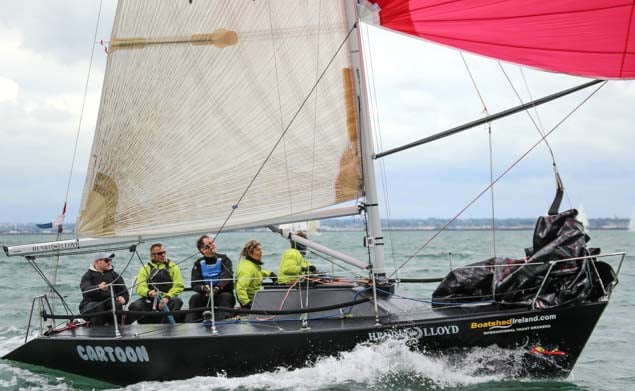 QUARTER TONNER Cartoon – Ken Lawless & Sybil McCormack from the Royal Irish Yacht Club. Photo: Afloat.ie
QUARTER TONNER Cartoon – Ken Lawless & Sybil McCormack from the Royal Irish Yacht Club. Photo: Afloat.ie
Cartoon V: Ken Lawless & Sybil McCormack (RIYC) with their characterful Quarter Tonner came sweeping through the IRC Nationals to win their class in style.
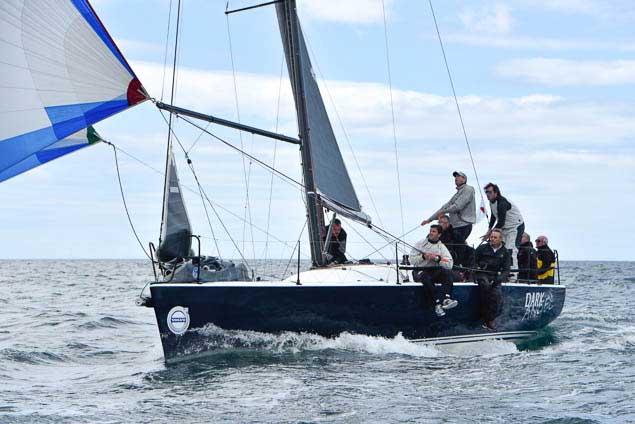 DUBOIS 37 Dark Angel – Tony Ackland from Swansea. Photo: Bob Bateman
DUBOIS 37 Dark Angel – Tony Ackland from Swansea. Photo: Bob Bateman
Dark Angel: Tony Ackland from Swansea turned all heads with his handsome boat which in a previous life was well known in both Cork Harbour and Galway. There’s more than just looks to the Angel – she won IRC 1 in the Europeans at Crosshaven.
 HALF TONNER Harmony – Jonny Swan from Howth Yacht Club. Photo: Bob Bateman
HALF TONNER Harmony – Jonny Swan from Howth Yacht Club. Photo: Bob Bateman
Harmony: Jonny Swan’s wooden-built classic Half Tonner Harmony benefitted from an under-deck laminated fore-and-aft girder installed by Dougal McMahon of Belmont in County Offaly literally to provide a bit of backbone, and it worked a treat. In many victories, Harmony won IRC 3 in the Europeans at Cork.
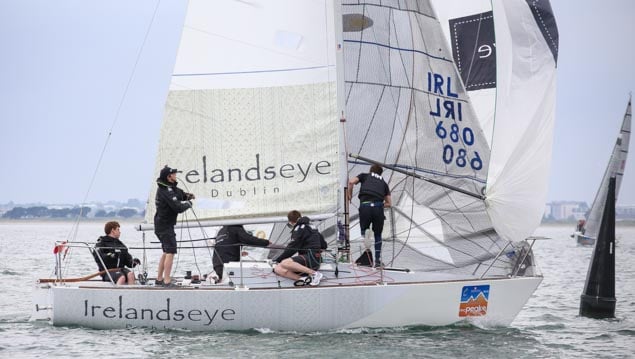 J24 Ireland's Eye Kilcullen – HYC under-25s from Howth Yacht Club
J24 Ireland's Eye Kilcullen – HYC under-25s from Howth Yacht Club
Ireland’s Eye Kilcullen: The HYC nippers – aka the under-25s – in the club-backed J/24 showed there’s still life in this classic Johnstone design. In open events they took second place in Class 4 at Cork Week and the IRC Europeans, they also took third overall in the J/24 Under 25 Europeans. And in the class in Ireland they won the Nationals (7 wins in 7 races), the Northerns, the Southerns, and the Westerns.
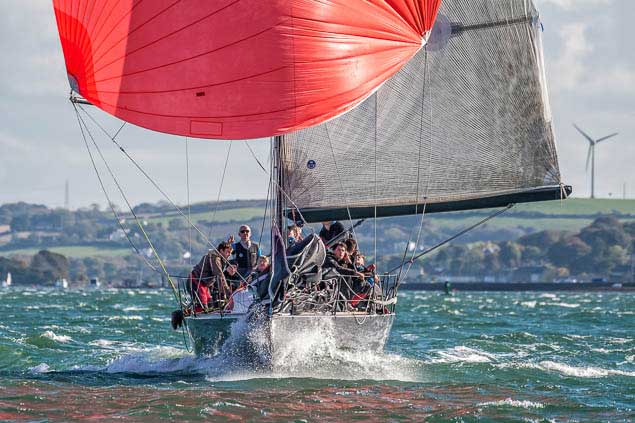 KER36 Jump Juice - Conor Phelan from Royal Cork Yacht Club. Photo: Bob Bateman
KER36 Jump Juice - Conor Phelan from Royal Cork Yacht Club. Photo: Bob Bateman
Jump Juice: Like good wine, Conor Phelan’s Ker 36 from Cork improves with age. They won the RORC Easter Challenge in ferocious weather in the Solent overall, and they won Class O in convincing style at the ICRA Nats in June.
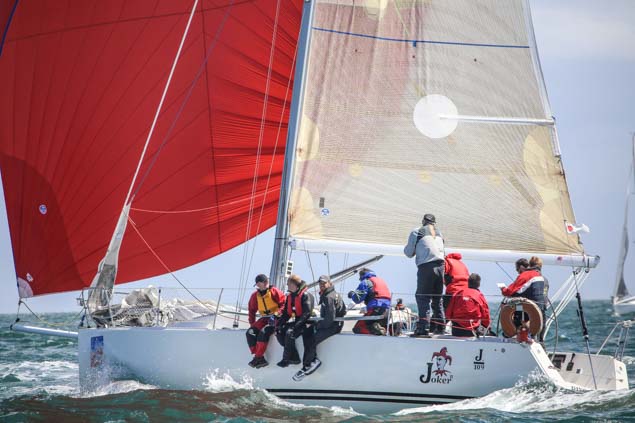 J109 Joker 2 - John Maybury from the Royal Irish Yacht Club. Photo: Afloat.ie
J109 Joker 2 - John Maybury from the Royal Irish Yacht Club. Photo: Afloat.ie
Joker 2: If you wanted a demonstration of the J/109’s all round ability, John Maybury’s Joker 2 provided it in 2016. She recorded a back-to-back win in the ICRA Nats – the only boat to do so in 2015-2016 – and under the skippering of Commandant Barry Byrne, she was the first winner of the new inter-forces Beaufort Cup including winning its Fastnet Race. Same boat, but completely different crews – Joker 2 makes a special claim for top boat of the year
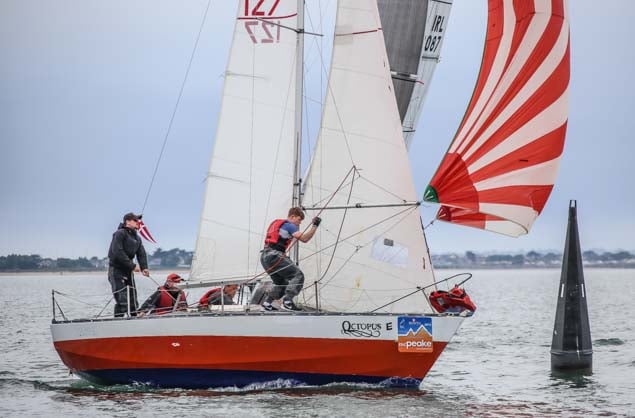 E–BOAT OctopussE - Pat O’Neill from Clontarf Yacht & Boat Club. Photo: Afloat.ie
E–BOAT OctopussE - Pat O’Neill from Clontarf Yacht & Boat Club. Photo: Afloat.ie
OctopussE: The Julian Everitt-designed E Boat is a blast from the past, a miniature offshore racer in which the vertical keel can be retracted completely into the hull. The fleet at Clontarf deserve every credit for their multiple use, including club racing and canal cruising. But it is Pat O’Neill who carries it all through with competition in the ICRA Nats, and he won IRC 4.
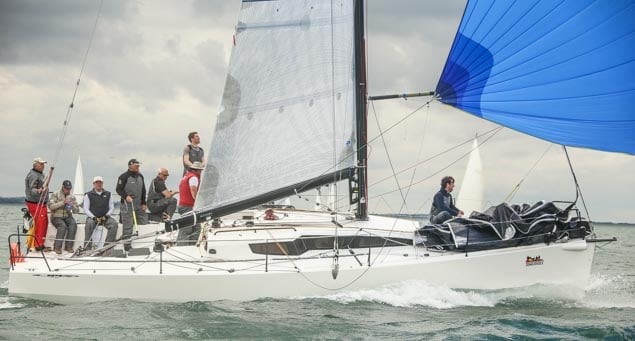 JPK 10.80 Rockabill – Paul O'Higgins from the Royal Irish Yacht Club. Photo: Afloat.ie
JPK 10.80 Rockabill – Paul O'Higgins from the Royal Irish Yacht Club. Photo: Afloat.ie
Rockabill VI: It takes courage to start racing in a boat with a massive international success record like the JPK 10.80, but Paul O’Higgins was game for the challenge when he took Rockabill VI fresh out of the wrappings to do the Volvo Round Ireland Race in June, and came within an ace of a class win. He then re-surfaced for the IRC Europeans at Cork in July – and won IRC 2.
- Votes: (0%)
- Votes: (0%)
- Votes: (0%)
- Votes: (0%)
- Votes: (0%)
- Votes: (0%)
- Votes: (0%)
- Votes: (0%)
- Votes: (0%)
- Votes: (0%)
- Votes: (0%)
- Votes: (0%)


| Total Votes: | |
| First Vote: | |
| Last Vote: |
Half Tonners Hit The Spot for Irish Sailing
With the confirmation that Kinsale Yacht Club will be hosting the Half Ton Classic Worlds from August 14th to 18th 2017, Irish interest will intensify further in a class which already attracts much favourable attention. W M Nixon tells us more about a popular boat type which will have a defending champion from Ireland when the Worlds get under way in Falmouth in Cornwall in a week’s time.
If today’s newcomers to sailing find the resurrection of old offshore racing classes which are apparently only identified by specific weights a bit bewildering, then they can blame the first Commodore of the National Yacht Club in Dun Laoghaire.
The first Commodore of the NYC in 1931 was the Earl of Granard. The club had been founded in 1870 as the Kingstown Royal Harbour Boat Club, and in 1901 it became the Edward Yacht Club in honour of one of Queen Victoria’s many offspring. But with the new mood of the times after Irish Independence in 1922, such a name just wouldn’t do. Nevertheless it was a very sporting gesture when one of the landed aristocracy proposed the new no-nonsense name in 1930, giving it a fair wind by agreeing to be Commodore the following year.
Thus the big change to becoming “The National Yacht Club” was made respectable. But then, the Earl of Granard was a well-respected sailing man in his own right, despite the fact that his ancestral pile in County Longford was about as far from the sea as you can get in Ireland.
Admittedly there was sailing nearby with the North Shannon Yacht Club on Lough Forbes, which incidentally is named after the earl’s family – they were connected to the Forbes of the famous business magazine in America. However, despite the joys of sailing on Lough Forbes, the Earl had long been into bigger things on the international scene, though his interest still had an inland waterways aspect. In 1899 he’d presented a magnificent silver cup to the leading French sailing club, the Cercle de la Voile de Paris (CVP) for an international competition, to be sailed on the River Seine near Paris or on the Solent at Cowes, with the racing between boats which weighed one ton.
Although the trophy’s official name was the Coupe Internationale du Cercle de la Voile de Paris, it soon became known as the One Ton Cup, and continued to be so named even when racing was between yachts of the International 6 Metre Class, despite their weighing several tons apiece.
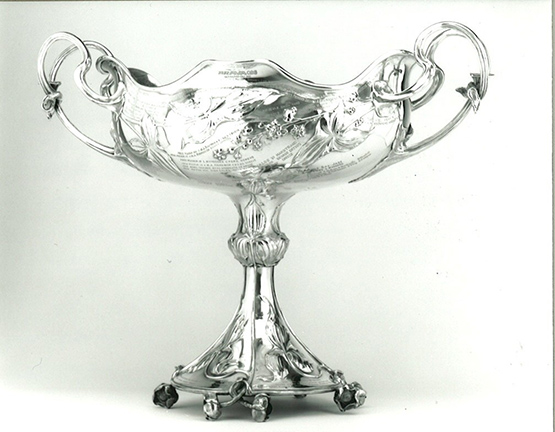 The cause of all the trouble – the One Ton Cup was presented to the CVP by the Earl of Granard, future Commodore of the National YC, in 1898, and was first raced for in 1899.
The cause of all the trouble – the One Ton Cup was presented to the CVP by the Earl of Granard, future Commodore of the National YC, in 1898, and was first raced for in 1899.
The magnificent cup remained as beautiful as ever, but with World War II it became almost forgotten until 1965, when the CVP proposed using it for an inshore-offshore international series for yachts rating at 22ft under the RORC rule, which worked out to be boats around the 36-37ft mark. The idea took off like a rocket - level-rating racing among diverse boats was an idea whose time had come. Very quickly, a whole range of additional international rating levels arose, with Two Tonners around 40-42ft, Three Quarter Tonners around 34ft, Half Tonners around 30ft, Quarter Tonners around 25ft, Mini-Tonners around 21ft, and they even had Micro-Tonners at about 18ft.
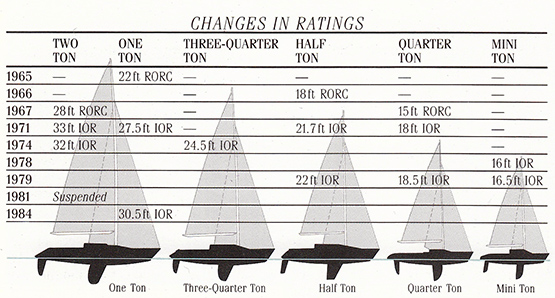 The Ton Classes at their peak
The Ton Classes at their peak
It all worked very well for twenty years and more in some cases (the last Half Tonner was built in 1992), with the boat sizes staying broadly the same size range, but with the ratings changed to accommodate the RORC rule being replaced by the IOR. And Irish sailing certainly had its moments in this continuing circus of various offshore racing acts. In 1974 the Ron Holland-designed, Cork–built 36ft Golden Apple somehow became more famous than the winner by being runner up the One Ton Worlds. But then in 1976, Harold Cudmore and a youthful crew from Cork put all questions aside by managing to get the new race-prepared Ron Holland-designed 30ft Silver Shamrock to Trieste for the Half Ton Worlds, and he won in style, famously celebrating by sailing up the Grand Canal in Venice with spinnaker set.
 The 1976 Half Ton World champion Silver Shamrock, getting an end-of-season lift-out at her current home port of Penzance in Cornwall
The 1976 Half Ton World champion Silver Shamrock, getting an end-of-season lift-out at her current home port of Penzance in Cornwall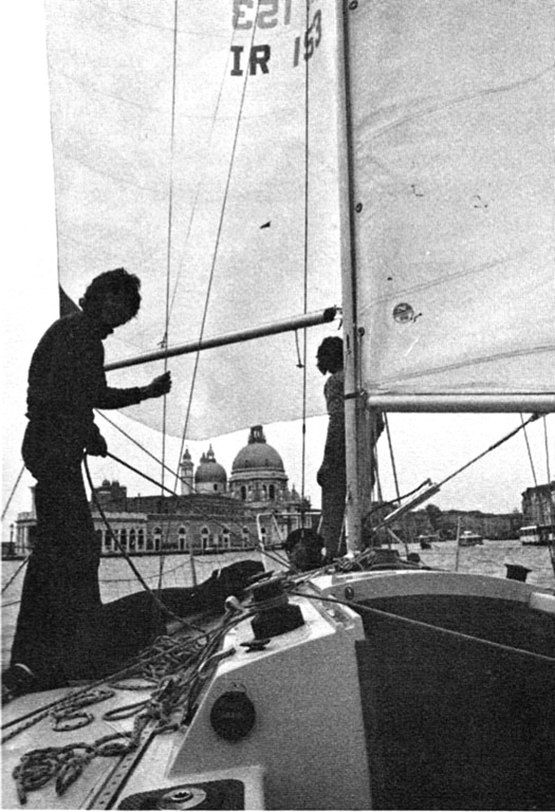 See the conquering heroes come…….Silver Shamrock sailing up the Grand Canal in Venice after winning the Half Ton Worlds 1976 in Trieste under Harold Cudmore’s command. Ronnie Dunphy on left, Killian Bushe on foredeck
See the conquering heroes come…….Silver Shamrock sailing up the Grand Canal in Venice after winning the Half Ton Worlds 1976 in Trieste under Harold Cudmore’s command. Ronnie Dunphy on left, Killian Bushe on foredeck
In 1981 he was back on top again, winning the One Ton Worlds at Crosshaven with the Castro-design Justine IV owned by Frank Woods (NYC). But by this time the boats involved were very different in form from those skinny-sterned designs which had dominated in the earlier 1970s, as a fresh wave of New Zealand designers like Bruce Farr and Laurie Davidson had been showing what could be achieved with broader sterns and better offwind performance.
The Half Ton Worlds was won in 1977, ’78 and ’79 by Kiwi boats of this type. But though she was not the overall winner, Ian Gibbs’ Farr-designed Swuzzlebubble was the one everyone remembered best, as she was on the podium one year as a centreboarder, and back there in the top three the year after, but this time as a keelboat.
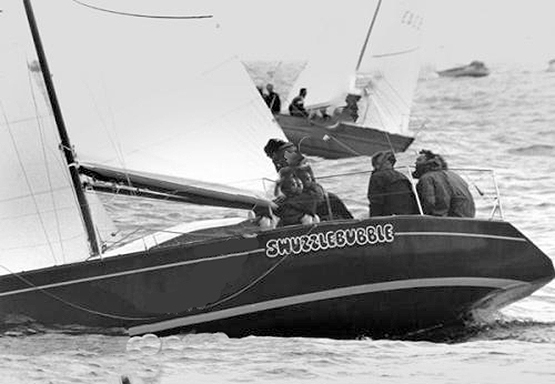 The new wave arrives from New Zealand – Swuzzlebubble in 1979
The new wave arrives from New Zealand – Swuzzlebubble in 1979
The following year she arrived in Ireland in the ownership of Bruce Lyster of Royal St George in Dun Laoghaire, and he won the ISORA Championship in 1980, plus ISORA Week and just about everything for which the boat was eligible in Cowes Week.
He had an exceptional crew of all the talents with Robert Dix, Drewry Pearson and Des Cummins, and Dixie remembers her as one of the most wonderful boats he ever sailed: “She found her own way to peak performance so effortlessly that you’d almost be scared to do anything which might adversely effect the trim” he quips.
He continues to say that even though Bruce Lyster sold Swuzzlebubble to Greece at season’s end, as you simply couldn’t improve on a season like they’d had in 1980. The Three Musketeers meanwhile transferred aboard Ken Rohan’s 40ft Regardless, with which they won their class big time in the 1981 Fastnet.
Regardless would be on most people’s short list for the greatest Irish racing yacht ever, yet Robert Dix remembers the previous season with Swuzzlebubble with even more enthusiasm. So it’s intriguing that at next week’s Henri Lloyd Half Ton Classics Worlds, the new wave of Irish Classic Half Ton sailors will be taking on Swuzzlebubble for the first time.
The story of her re-birth is typical of the modern revival of the very best of the old Ton Cup boats, with the One Ton Championship itself being revived for its Golden Jubilee in New Zealand in 2015 with a classic fleet. As for Swuzzlebubble, she was discovered in a very poor way indeed in a Greek boatyard in 2012, but was brought back to life by the King of Cowes, Peter Morton, who duly won the Half Ton Classics Worlds in Brittany in 2014 with her.
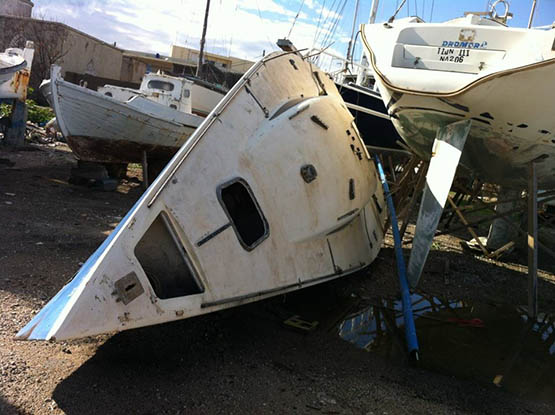 Next stop, the landfill site? Swuzzlebubble as she was found in Greece in 2012
Next stop, the landfill site? Swuzzlebubble as she was found in Greece in 2012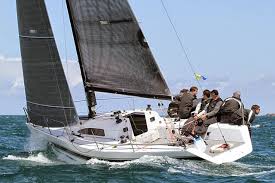 Swuzzlebubble restored, on her way to winning the Half Ton Classics in Brittany in 2014
Swuzzlebubble restored, on her way to winning the Half Ton Classics in Brittany in 2014
However, Swuzzlebubble wasn’t campaigned in the 2015 series in Belgium, when Dave Cullen took the trophy for Ireland with Checkmate XV. So there has been an air of unfinished business about these two rather special boats floating about the ocean without actually locking horns, but that’s all going to be changed in Falmouth.
 Dave Cullen on the helm as Checkmate XV makes a start to die for at the Half Ton Worlds in Belgium, 2015
Dave Cullen on the helm as Checkmate XV makes a start to die for at the Half Ton Worlds in Belgium, 2015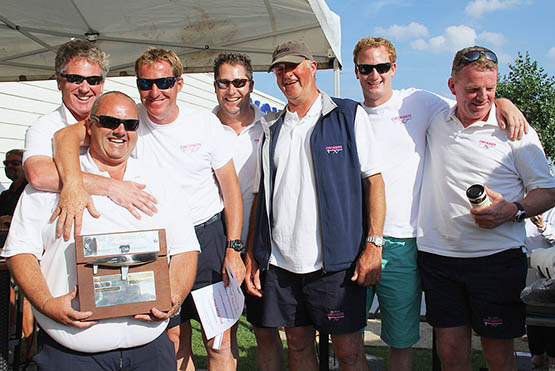 Winners take all – Dave Cullen and his crew with the trophy after victory last year
Winners take all – Dave Cullen and his crew with the trophy after victory last year
In fact, it has become Howth versus Falmouth, as Swuzzlebubble is now Falmouth-owned by Gregory Peck who, in a very varied sailing career, was one of the crew with Dickie Gomes aboard the 83ft catamaran Novanet when a new Round Ireland Record was established in November 1986, but that’s another story altogether.
However, in Falmouth there’ll be other boats involved too, as the word is they might muster as many as 30 entries, which is as big a fleet as anyone could reasonably wish for. The remarkable Howth/Fingal contingent will be there in full strength, as Checkmate XV will be taking the road with Jonny Swann’s Harmony, Michael and Richard Evans’ The Big Picture, and the David Kelly and Patrick Boardman team from Rush SC with King One, Half Ton World Champion in 1981.
It’s an intriguing mixture of nostalgia and modernity, as the boats get revamped to new ideas, yet they always carry their history lightly but definitely with them. In the case of the Howth boats, much of the technical work in revamping is done by ace boatbuilder Alan Power of Malahide, who appropriately is a powerboat nut himself, but his ability to think outside the usual boat-building box makes him the ideal man to undertake crazy notions for addicts of old but still potent offshore racers.
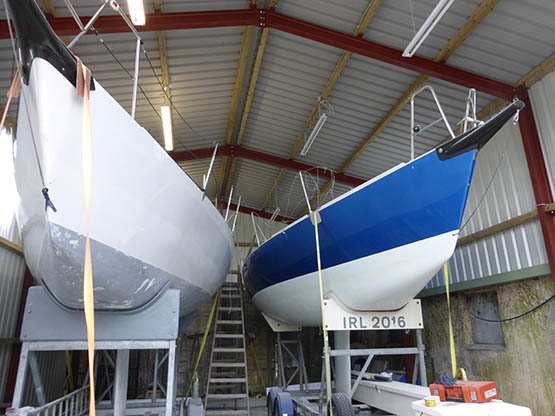
In line with this aim of maximising performance, the Howth/Fingal crewing lineup will include some formidable talent from all over Ireland, with Dave Cullen leading the charge with his 2015 crew of Johnny Murphy, Gary Cullen (no relation), Aidan Beggan, Mark Pettit, James Hynes and Andy George.
The crew on The Big Picture meanwhile have roped in Mark Mansfield of Cork, who is having a great year of it in a variety of boats, while the jockey for King One is young Marty O’Leary, one of the bright new talents to emerge in recent years from Courtown in County Wexford.
Down Falmouth way, it’s going to be Classic Half Ton Racing at its classic best. And if you wonder why it is that the Half Tonners seem to have been the most successful of all the Ton classes in reviving themselves after more than fifty years, perhaps the answer is that at 30ft they’re big enough as boats to be taken seriously, yet small enough to be a manageable proposition for keeping in top order and raced keenly.
 The contemporary Half Ton Classics lineup – the boats are big enough to be taken seriously, yet small enough to be manageable
The contemporary Half Ton Classics lineup – the boats are big enough to be taken seriously, yet small enough to be manageable
With the start of the Henri Lloyd Half Ton Classics Cup 2016 fast approaching on Monday 15 August the Half Ton Classics and the town of Falmouth are in the final stages of preparation for what promises to be a bumper edition of this delightful annual event. With at least 30 teams expected to travel to Falmouth from across the UK, Ireland and Europe, competition will be fierce as these historic little ships do battle against the spectacular backdrop of the Cornish coastline.
Among those already entered is Ireland's David Cullen, who won the 2015 Half Ton Classics Cup and will be back to defend his title in his 1985 Humphreys MG HS30 Checkmate XV. Originally named Blue Chip, the boat was purchased by Nigel Biggs in 2012 who put the boat through a major refit with Corby Yachts. David purchased her from Nigel over the winter of 2014/15 and she once again went into Corby Yachts, this time to have a new cockpit and transom fitted. At the time his 2015 victory David noted "It's a very tricky boat. The new boats are very powerful and we're still trying to figure it out. But we've learnt a lot this week and we look forward to moving forward and maybe being a little bit faster for Falmouth next year." With another year of sailing the boat under their belts since then it will be interesting to see if they are that little bit faster.
Also making the trip from Ireland for the event are Jonny Swan with Harmony, which was built by Priors of Burnham in 1980 to a Rob Humphreys' design for Mike Holmes and Tony Allen (of Holt-Allen fame) and is widely regarded as one of the most successful Half Tonners ever built. Kelly Boardman from Howth is racing King 1, which was previously owned by Cullen and Michael and Richard Evans will be competing in their Humphreys MG30 Big Picture.
Belgium will be putting forward several strong teams led by Philippe Pilate's 1978 Berret designed General Tapioca which won the 2009 Half Ton Classics Cup in Nieuwpoort, but broke their mast during the 2015 event so will be hoping for better luck this year. Also coming from Belgium are Ian Van Burm's 1983 Humphreys one off Fantasy and Thibaut Martin's MG HS30 Spip.
Heading up the British contingent will be 2014 Half Ton Classics Cup winner Peter Morton's 1977 Bruce Farr designed Swuzzlebubble which will be helmed by Greg Peck. Peter Rutter has entered his recently purchased 1985 Andrieu designed Insatiable, which has been renamed Quokka 9. From the East Coast come Anthony Meehan and Jane Mardell's Lynx and David Evan's Hullabaloo XV.
There will also be a strong showing from the local Falmouth Half Ton fleet with entries from Paul Pullen's Miss Whiplash, Mel Sharp's Demolition, John Hicks' Rampage, Geoff Davies' Scorpion and Jonathan Cunliffe's legendary Emiliano Zapata.
As well as racing in the event Paul Pullen is also a key player on the oganising committee and is very much looking forward to welcoming such a strong fleet of half tonners to his home town. "We have been working and training very hard this year, we are really looking forward to sailing against all the top boats in our own back yard. We're lucky to have some of Europe's best sailing waters right on our doorstep and with the experience, enthusiasm and commitment of Flushing Sailing Club and our local team of volunteers and sponsors behind us it's going to be a fantastic event."
The Henri Lloyd Half Ton Classics Cup 2016 is being hosted by Flushing Sailing Club and registration for the regatta opens on Saturday 13 August and continues on Sunday 14 August. Monday will feature a practice race followed by windward leeward races. From Tuesday to Friday the fleet will sail a mixture of windward leeward, regatta and coastal courses. Inshore races will be run in Falmouth Bay or Carrick Roads and the coastal race will be run within a 10-mile radius of Black Rock Beacon.
The boats will be moored at Pendennis Marina with the Regatta marquee located on Falmouth's Event Square, adjacent to the National Maritime Museum of Cornwall. An extensive social programme for competitors and their friends and families will center around Flushing Sailing Club, the Regatta marquee and the Museum, which will host the Championship Dinner.
The attraction of boats and the sea as a year-round fascination is something which by-passes many people. And even in summer – particularly if it’s a typical Irish summer – you’d sometimes be hard put to explain the appeal of our eccentric sport in its multiple manifestations to those who were only taking a polite interest in the first place. W M Nixon adds to the mystery by considering the unexpected interactions which come up on a typical day as the new season creaks into action.
“It’s an old Boston Whaler” says Grant McEwen, “a very old Boston Whaler. Long forgotten too, by the look of it. Most people would have thought it was fit only for the landfill site But the new owner wants it restored to best original order, proper Concours d’Elegance stuff. What do you think of that?”
“It’s absolutely marvellous” says I. “By my reckoning, the Boston Whaler in all its manifestations is classic. You just can’t do too much good work by a proper classic boat. Go for it!”
The men who work on boats in hidden workshops – Alan Power and Grant McEwen out the back of Malahide. Photo: W M Nixon
This tired-looking Boston Whaler may be as much as fifty years old, but with the proper restoration skills in Malahide she’ll be brought to Concours d’Elegance standards as a real classic. Photo: W M Nixon
We’re in one of those semi-secret little places where boat nuts gather. It’s a yard up the back of Malahide out the back of a small business park, a place where little one and two-man businesses - some of them in the marine industry - have clustered, because the reality of waterfront property in the Dublin area is that it has become much too expensive to provide decent premises for boat businesses operating on very tight margins.
Yet in these hidden and unassuming places, you’ll find some really amazing things going on. But they’re amazing only if you’re a dyed-in-the-wool boat enthusiast. So we’re not even talking about all sailing people here. Some sailing and boating people just don’t want to know about the hidden details of boats and their equipment, and how things came to be that way. They just want to go sailing, or zip around the sea under power. The work behind the scenes is not for them.
But for the rest of us, sailing and boating are of heightened interest because they’re vehicle sports. The vehicles themselves are every bit as interesting as the sport you can have with them. And from that, of course, there springs the notion that with a bit of change here and there - a minor tweak of this, and a minor adjustment of that – then hey presto, you’ve got a much improved boat.
As it happens, the finding of this Boston Whaler brought in for the Lazarus treatment was a fortuitously associated event, as I’d called to this secret yard in Malahide to shoot the breeze with one of Grant’s neighbours, Alan Power. He is known among the cognoscenti as the man to go to when you want your boat modified in interesting ways. He’s the kind of genius with epoxies and whatnot who will cheerfully take on a challenge which other workers around boats couldn’t even contemplate, let alone try.
Yet Alan will take on the job, and he has done so with such success in recent years that he has had an additional new shed built on the only spare bit of ground left in this secret yard, a shed big enough to accommodate two Half Tonners side by side.
“We’ve a World Champion out the back”. Re-vitalised Half Tonners The Big Picture (left) and World Champion Checkmate in Power Marine’s new shed in Malahide. Photo W M Nixon
Half Tonners are boats around the 30ft LOA mark which were all the rage as the hottest international level rating keelboat class around 30 years ago, when they were so highly-regarded that the likes of Olympic sailing legend Paul Elvstrom of Denmark got intensely involved. But this level of participation ultimately led to a sort of self-immolation of the class, even though the boats were still around, though now racing as ordinary handicap craft.
But as the years have passed, people have come to realize that the Half Tonner is a very manageable proposition as a classic, and thanks to modern construction, many examples of the great designs of the class’s golden years have survived remarkably well. All they need is a bit of TLC and maybe a bit of repair and tweaking here and there, and this is where Alan Power of Power Marine comes in, for no-one does it better.
The irony of it all is that Alan himself is a powerboat fanatic, both building and racing. Last weekend he was competing with the Irish contingent in the major international powerboat event at Torquay in Devon, Rounds 1 & 2 of the RYA British OCR (Offshore Racing Circuit) Championship. Roughly speaking, it’s the powerboat equivalent of saloon car racing, and this time round it was Alan’s brother Mark, navigated by Carl Kendellen, who showed best with a sixth in class and ninth overall. But in times past Alan has frequently been on the podium, and he has some Gold Medals to show for his efforts. So now that he has the new shed up and running, he has been able to devote his original shed to one of his personal pet projects, a very hungry looking powerboat to his own designs.

Mark Power’s boat was the most successful of the Irish contingent at last weekend’s Offshore Circuit Racing (ORC) event in Torquay in Devon

This British competitor at last weekend’s Torquay series was a successful Power Marine export order
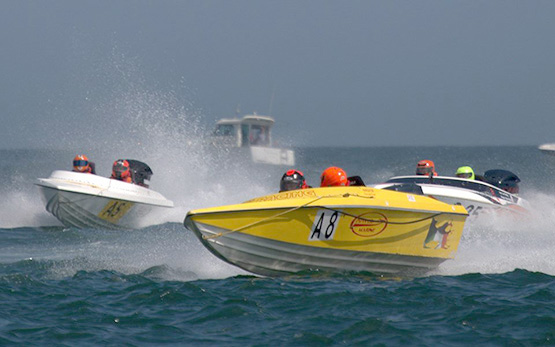
Powering ahead. Mark Power and Carl Kendellen find themselves in the sweet place in last weekend’s racing
It may seem odd that the development of a new prototype racing powerboat is in a sense being funded by the maintenance and modification requirements of handicap racing sailboats, but either way it’s specialist boat-building, and the skills are very transferable.
Fortunately, Alan hasn’t set himself too strict a deadline on this particular new craft, for with the economy picking up again, people are getting around to commissioning those modifications on sailboats that they’ve had in mind for some time, and as well there’s always a steady stream of repair work at Power Marine.
A month ago, the new shed was busy with two of the top Half Tonners in dock, Dave Cullen’s World Champion Classic half Tonner Checkmate XV and the Evans brothers’ The Big Picture. Checkmate is now afloat and competing, but The Big Picture is having further mods made, and meanwhile waiting outside is Ken Lawless’s handy little Quarter Tonner Cartoon, which is in the yard to get the Power treatment for her rudder.
Ken Lawless’s Quarter Tonner Cartoon in Power Marine for some fine tuning of the rudder
Once again, this is where boat nuts and ordinary sailors part company. For your ordinary sailor, a rudder is just a rudder. But for boat nuts, a rudder is a source of endless fascination, an item for almost eternal modification. What with creating the best-possible endplate effect at the hull, or reducing turbulence from the trailing edge, for your boat nut there’s not really a rudder on the planet which can’t be improved, however infinitesimally small the mods might be.
For non-enthusiasts, this might seem like something akin to debating how many angels can dance on the head of a pin, but I remained happily absorbed in a brief lecture by Alan – complete with sketches on a whiteboard – on the ideal configuration for the trailing edge of a rudder, which is not a knife edge as you’d expect, but is instead a small flat cutoff at about 45 degrees.
The artist in his studio – Alan Power sketching out the ideal trailing edge for a Quarter Tonner’s rudder. Photo: W M Nixon
The visit to Power Marine was prompted by a sunny Bob Bateman photo we had here on Afoat.ie a few days back of a Half Tonner swanning along in classic yachting style. This evoked contrasting memories of seeing Alan Power back in early April when work was going flat out on the two Half Tonners, and there was ample evidence of the dust-creating ability of an adult angle-grinder, with the man himself emerging from the back of the shed looking like something out of a horror movie. For sure, it’s wonderful to think of people sailing along in that healthy style as shown by the Bateman photo. But just now and again it does no harm to remember how much effort has to go into bringing a boat such as a vintage Half Tonner up to full racing potential.
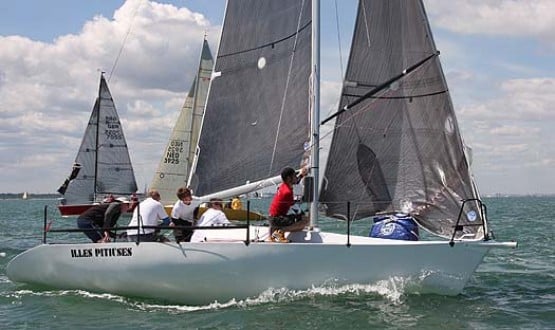
Champagne sailing. It was this idyllic image on Afloat.ie which prompted a visit to the dusty reality of a modern boatworking shed. Photo: Robert Bateman
Yet it would be pointless for all this effort to be put through in dusty premises unless the customers go out and sail and race the boat with the same dedication, and all credit to Dave Cullen, he does that very thing, and became our Sailor of the Month last August for trailing Checkmate XV to Belgium and winning the Half Ton Classics 2015.
He has an even busier season planned this year, as Checkmate has work to do at Dave’s home port of Howth in the ICRA Nationals from 10th to 12th June, but then a few days later he moves into a different scene with the complete charter of the Kelly family’s J/109 Storm, which becomes Euro Car Parks for the Volvo Round Ireland race on June 18th, crewed by five of the Checkmates plus Maurice Prof O’Connell - as the Checkmates who won the Half Ton Worlds make up a Who’s Who of Irish sailing talent, this is one potent challenge.
But Checkmate herself isn’t forgotten, for in August she has to defend her world title in Falmouth, which is as lovely a place to sail as you’ll find in a many a weeks voyaging. It’s all a very long way from a busy boatworking shed somewhere out the back of Malahide. But that’s the way it is with this crazy sport of ours.
Is it a bird? Is it a plane? Is it a bath……? No, it’s the mould for the new cathedral hull raceboat from Power Marine, which will be slightly similar to the red machine in the poster on the wall. Photo: W M Nixon




























